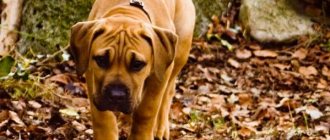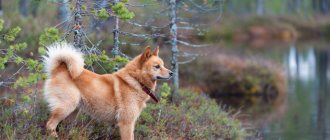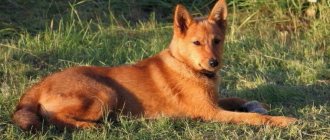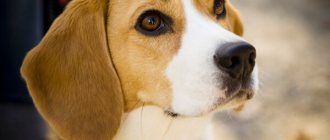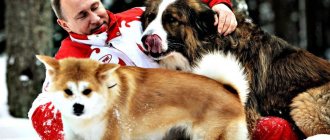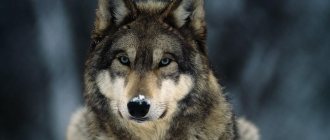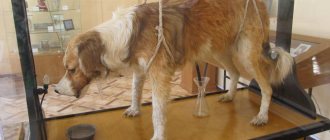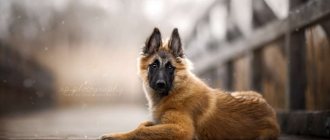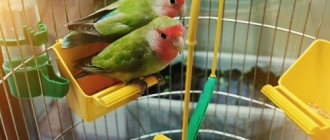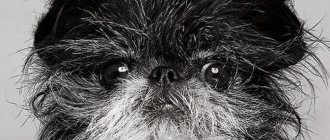Boerboel. South African Boerboel. Today, Boerboel puppies are popular among breeders, who want to buy this breed quite a lot. But why are these dogs so attractive?
As you know, a dog is man's friend. Different dog breeders have different requirements for their pets. A four-legged pet should be a protector, a companion, an assistant. The dog's attractive appearance also plays an important role. The South African Boerboel combines fighting endurance and special beauty.
Those who are planning
to buy a Boerboel should familiarize themselves with the reasons for choosing this particular dog.
History of the origin of the Boerboel dog breed
The breed began its history as a farm dog of settlers back in the 17th century. Settlers from Western countries arriving at the Cape of Good Hope brought with them their dogs for guarding and hunting.
Among the animals that arrived were large mastiff-like dogs. The colonists moved further into the continent, engaged in farming and agriculture, and their dogs were isolated from the outside world, and breeding work was carried out in a very limited blood diversity.
Natural selection played a role in the formation of the breed. Farmers kept only strong, obedient, hardy, unpretentious, healthy dogs for further breeding. Weak individuals did not survive in harsh African conditions. Then the characteristic features of the South African Boerboel breed began to appear.
- The growth of cities and the desire for urban life threatened the national breed.
- Active restoration of the Boerboel began in the 80s, when the South African Association of Breed Fans was created.
- In 1990, the Association of Boerboel Breeders in Africa was created. The dogs became famous outside their homeland.
- In Russia, the first Boerboels appeared in 1998, and the NKP was created in 2001.
The breed is not recognized by the FCI.
History of the breed
The African or South African Boerboel has an ancient and rich history. This breed is the ancestor of the Mastiff and also represents the African Molossoid lineage. Scientists insist on the Asian origin of Boerboels. They believe that during the migration, the dogs ended up in Egypt, where they were discovered by Alexander the Great. He appreciated the fighting qualities of the dogs and made them part of the army that returned to Europe. Some scientists believe that Boerboels are the ancestors of many European breeds.
According to another version, they came to Africa from Europe, where they mixed with aboriginal dogs. In any case, Boerboels formed independently and went through all the stages of natural selection. Their appearance has not changed for centuries. By the 17th century, the number of Boerboels had decreased significantly, so the inhabitants of the Cape of Good Hope took selection into their own hands. They managed to restore the population and introduce dogs to work on farms. They successfully coped with the task of watchmen and hunters. In the 20th century, Boerboels ceased to be so popular and the situation repeated itself: the breed had to be restored bit by bit. The process was completed in the 80s, and dogs spread throughout the world.
Appearance of the breed
This is a large, massive, but not gigantic dog, heavy, with well-developed muscles, but very agile, dexterous and fast. The Boerboel is a very balanced dog, strong, wide, stocky, combining strength and lightness. The dog should not be raw, i.e. have drooping eyelids, long jowls and wrinkled, loose skin.
The head and body of dogs in profile look like a rectangle. The head is muscular, wide, massive, short. The ears are hanging, pressed to the head.
Standard sizes:
- The ideal height of males is 66 cm (less than 60 is defective);
- The ideal height of bitches is 61 cm (less than 55 – defective).
Boerboel weight: should be proportional to height.
Color (with and without mask):
- Solid fawn, red;
- Brindle (black brindles on the above background).
Small white spots on the chest and legs are allowed.
- The dog's coat is short, very thick and smooth. Long hair is a breed defect.
- The tail is set high, thick, traditionally docked (3-4 vertebrae) or natural length. A curled tail is a breed defect.
The limbs are strong, muscular, not long, providing powerful, free movements.
Breed characteristics of dogs
In their homeland, representatives of the breed must be tested for dysplasia in order to be allowed into breeding.
- In South Africa, a point system is used to evaluate the quality of dogs.
- Boerboels with a score of 70 or more are suitable for breeding use.
- Over 80 is a very good dog. Only a few get more than 90, because 100 is an ideal that does not exist in nature.
- This assessment method in South Africa serves as approval for breeding.
Pros and cons of the breed
| + | – |
| Excellent security qualities | Has negative reviews |
| Family devotion | Requires strict and regular training |
| With proper training, gets along with cats | Not suitable for beginners |
| Boerboel and children - a safe combination | Tends to be dominant and aggressive |
| Living in an apartment is acceptable | Males cannot tolerate their relatives |
| Sheds moderately | There are known cases of attacks on humans |
| They love activity and agility training. | Requires strenuous training |
The South African Boerboel is a difficult breed to train. It is suitable for strong-willed, decisive people who will not compromise with their dog. Training should be carried out under the supervision of dog handlers. Even though these dogs require an iron fist, they need love and care. If treated correctly, the Boerboel will become a kind and loyal friend.
Boerboel character
A correct description of the Boerboel breed can only be given by its national standard.
The breed standard defines them as calm, courageous, very self-confident, balanced dogs. Representatives of the breed are very loyal to all family members and are infinitely devoted to them.
- This characteristic of the Boerboel, such as a pronounced guard instinct, makes it a fearless defender of housing and property.
- A photo of a Boerboel dog may look a little scary, but these are absolutely adequate animals with a cool head and an iron psyche.
- Raising and training dogs of this breed should begin as early as possible. Boerboels are very intelligent, love to learn and have excellent learning abilities.
- Boerboels perfectly master obedience standards (OKD), love protective programs, and are happy to do tricks.
- Aggressive and cowardly individuals should be excluded from the breeding program and are a waste of the breed.
Breed characteristics and character
The South African Boerboel is one of the breeds that is not recognized by the largest international canine community, the FCI. In addition to this, some breeders put stamps on the dog such as “tailless mastiff” or “half-breed”.
In fact, Boerboels have mastiffs as relatives, but they certainly cannot be called half-breeds or mestizos. This is a separate breed, the roots of which are directed to the distant past.
Battles involving them are described in historical references dating back hundreds of years. The dogs, described as similar to Boerboels, were participants in gladiator fights in Britain. Towards the middle of the 16th century, animals began to spread across the lands of the Republic of South Africa.
People who settled on the Cape of Good Hope took many dogs as guards, so the island sheltered various guard breeds from Europe. It is difficult to say with certainty who exactly is the progenitor of modern Boerboels. In addition, dogs performed the functions of farmers - tending herds and flocks.
By the end of the twentieth century the Boerboel breed had completely disappeared from the face of the earth - the process of urbanization and the no longer need for protection and conservation led to this. However, dog handlers realized it in time and quickly began to restore the breed. There were breeders, kennel owners and several African enthusiasts who were able to achieve the breeding and distribution of dogs throughout the globe.
The dogs quickly began to gain popularity due to their independent and balanced character. But at the same time, it is important to remember the ancient instincts of a protector. A dog can easily attack a person and even bite someone who encroaches on someone else’s territory.
It is important that the dog is socialized from puppyhood and raised among people. He is easy to train and train. However, your dog will need a leash and a muzzle when walking.
Boerboel care
Boerboels do not require special care.
- From childhood, accustom your puppy to hygiene procedures: examination of teeth, ears, eyes, paws, combing fur, etc.
- This will allow you to easily carry out the necessary procedures in the future.
- If the dog does not wear down its claws naturally (on hard surfaces), they must be shortened with special clippers.
During the shedding season, twice a year, dogs need to be combed well.
You should not wash your dog often. On good nutrition, dogs do not have the characteristic dog smell and washing 1-2 a year is more than enough. If an unpleasant odor appears, this is a reason to change your diet and consult a doctor.
Care and maintenance
The homeland of this breed is Africa, so the dogs cannot boast of a warm coat. It is preferable for them to be kept in a house or apartment. Some owners allow Boerboels into the house only during periods of severe frost. Practice has shown that the breed can live at low temperatures, but such conditions cannot be called suitable. An acceptable option is an enclosure + an insulated booth.
The Boerboel coat does not require careful grooming. It is enough to brush your dog regularly with a rubber mitt or a massage brush. During the molting period, the procedure is carried out more often than usual.
Boerboels are prone to colds, so they should not be bathed often. This is especially true for the winter months.
The optimal bathing regime is twice a year. In between, it is enough to wipe the dogs with a towel soaked in water. The ears are examined regularly and cleaned 2 times a month. During the procedure, use a cotton pad soaked in warm water, and not a cotton swab - it can injure the hearing organs. Clean only the outer part of the ear to avoid damage and injury. Eyes are wiped once every 3 days. To do this, use a cotton swab dipped in chamomile infusion.
Nails are trimmed as needed. If the dog spends a lot of time walking, they will wear off on their own.
Nutrition
Boerboels can be fed both high-quality dry food and home-cooked meals. The main thing to remember is that natural nutrition should be balanced and accompanied by taking a complex of vitamins and minerals.
Your diet of natural foods should include:
- beef (on an ongoing basis);
- lamb, poultry, horse meat, goat meat (1-2 times a week);
- 9% cottage cheese;
- organic yogurt;
- sea fish (occasionally);
- raw chicken egg (1-2 times a week);
- raw quail egg (can be given daily);
- crushed cereals - chaff, rice, buckwheat;
- carrots, onions, rice, tomatoes, cucumbers, pumpkin, zucchini, cauliflower;
- prunes, dried apricots;
- fresh fruits (except citrus fruits, bananas, raisins and grapes).
The share of meat should be at least 40-50% of the daily diet. It is better to give it in one piece. The ideal option is slightly frozen meat. After meals, it is useful to give raw cartilage and bones, except poultry. It is better to dilute cottage cheese with bio-yogurt. The share of fermented milk products should be 50% of the daily diet. However, you should not give it more than 2 times a week. Porridge should be given in moderation. It is better to replace it with boiled vegetables.
List of prohibited products:
- River fish;
- pollock;
- chicken skin;
- legumes and potatoes;
- citrus;
- grapes and raisins;
- nuts;
- bananas;
- milk;
- tubular bones;
- white bread, baked goods;
- fat;
- roast;
- salty;
- confectionery.
If the owner prefers to feed his pet dry food, it should be at least premium class. In the factory-produced feed market, the “price-quality” rule applies. Cheap products contain flavor enhancers and have a poor composition. They can cause urolithiasis.
Quality feed:
- Acana;
- Canidae;
- GO!;
- Grandorf;
- Innova;
- Orijen;
- Belcando;
- Hill's.
These products have a large number of positive reviews and are recommended by veterinarians.
Boerboel weight by month will help avoid pet obesity:
| Age | Weight |
| 1 month | 4-6 kg |
| 2 months | 8-12 kg |
| 3 months | 14-18 kg |
| 4 months | 20-26 kg |
| 6 months | 26-32 kg |
| 7 months | 36-43 kg |
| 8 months | 40-48 kg |
| 9 months | 44-52 kg |
| 1 year | 50-60 kg |
| 2 years | 60-80 kg |
To find out how much a puppy should weigh at each stage of development, it is necessary to take into account height and average weight gain.
Health and life expectancy
The South African Boerboel is a healthy and hardy dog breed. During development, it went through natural selection, so it does not have a long list of diseases. The most common problems include vaginal hyperplasia, hip and elbow dysplasia. Average life expectancy: 12-15 years.
Content
Boerboels adapt perfectly to both life in a city apartment and life in a country house. In central Russia, you should not keep a dog on the street. In the room for bedding, it is better to choose a quiet place, protected from drafts.
Boerboels are hardy, strong dogs. They require physical activity commensurate with their age. You should not put stress on a growing Boerboel, as this can damage the ligaments and joints.
Training
The Boerboel is a dominant breed, so it is important to raise the puppy correctly. If the owner makes a number of serious mistakes, he will end up with a physically strong, uncontrollable dog. This combination is deadly.
The puppy is prohibited from:
- bite the owner even during play;
- pull on the leash;
- jump on people and lean on them with their paws;
- pick up trash and other items on the street;
- show aggression towards relatives and pets.
This breed must be trained uncompromisingly and firmly (not cruelly). The command “come to me” must be carried out unquestioningly.
Boerboels are not suitable for house training. When purchasing a puppy, the owner must provide documentation of basic training skills. From an early age, the puppy is taken to classes with a dog handler and taught to obey. If a person is not sure that he can cope with such a powerful dog, it is better for him to choose another breed.
Nutrition
You should not overfeed a growing dog; the consequences can sadly affect the entire future life of the Boerboel. For an adult dog, excess weight will also be dangerous due to the large weight and the enormous load on the musculoskeletal system.
- The dog's diet should be balanced, taking into account food allergies (if any) and eliminating their sources from the diet.
- It is possible to feed both natural products and ready-made high-quality factory feed.
- Dogs are prohibited from sweets, salty foods, smoked foods, any boiled bones, or raw tubular bones.
- In winter and during increased physical activity, a higher calorie diet is needed.
Health
These strong guys have excellent health, which has been confirmed historically. Of course, modern breeding has changed this quite a lot.
- The weakest point of the modern Boerboel is diseases of the musculoskeletal system: dysplasia, bursitis, arthritis, ligament damage.
- Otitis of various natures often occurs, which is typical for dogs with floppy ears.
You should also avoid excess weight, which puts enormous strain on the heart and joints.
